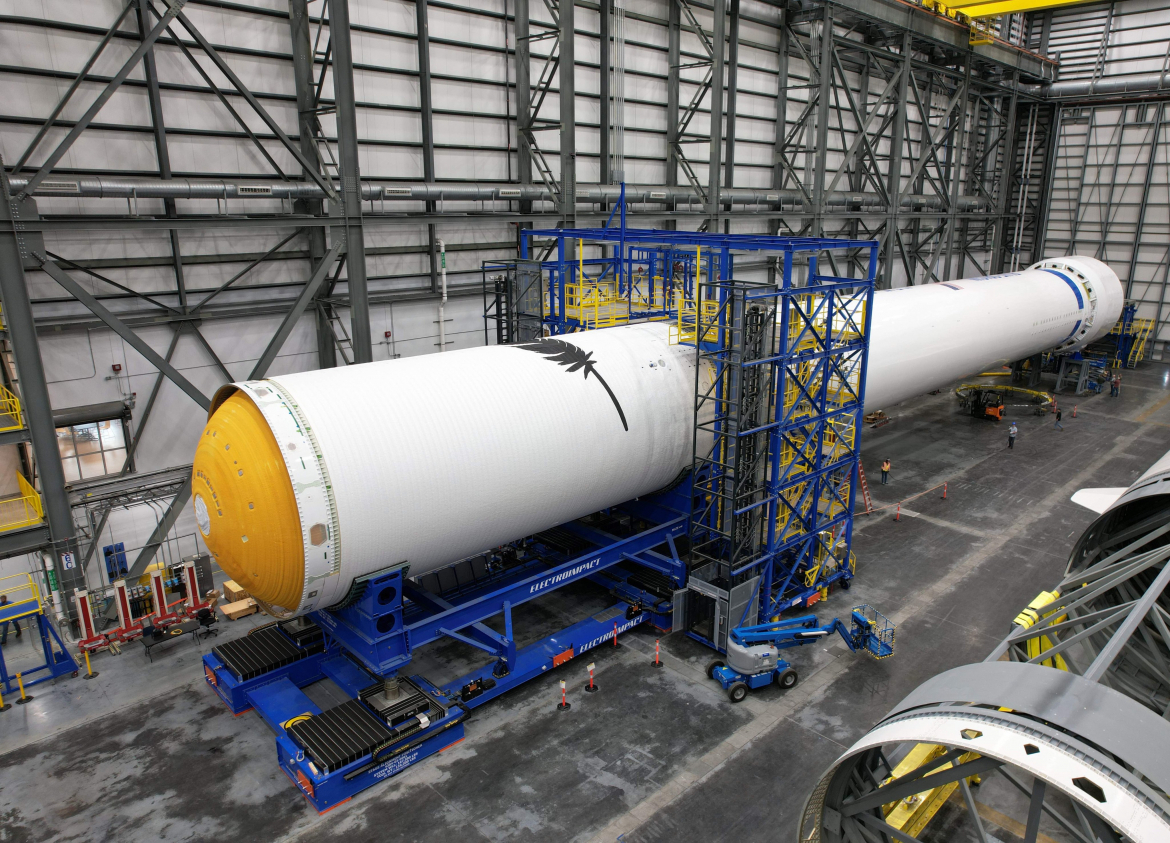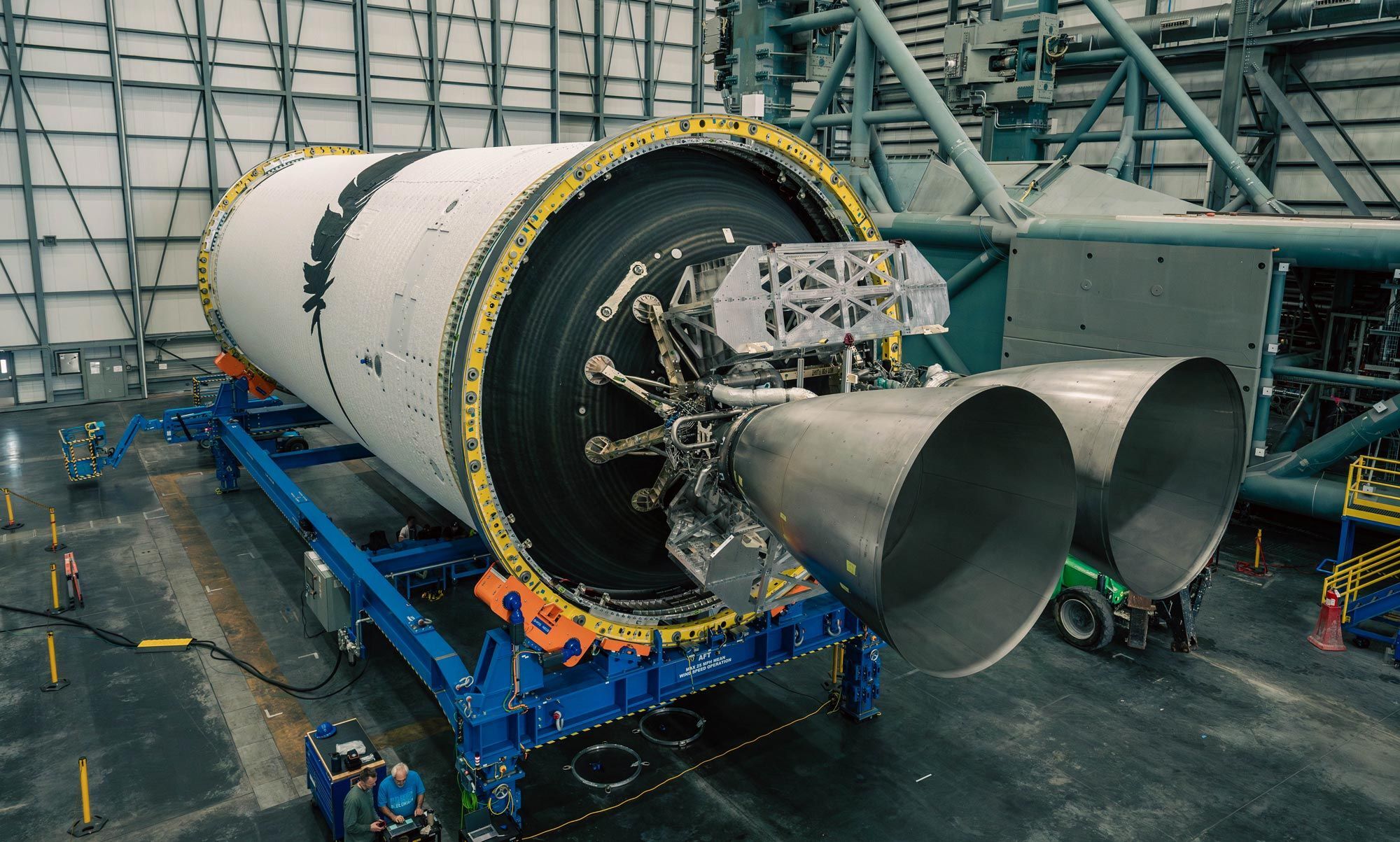31.01.2024

As the first month of 2024 closes, Blue Origin is well into production with its orbital rocket, New Glenn. The company continues to check off major milestones as high-fidelity hardware arrives at Launch Complex 36 (LC-36) ahead of a testing campaign and a NASA mission scheduled for late 2024.
With New Glenn being 98 meters tall and seven meters wide, the vehicle is a large step up from the company’s suborbital rocket, New Shepard. This presents new challenges with design, manufacturing, transport, and testing. However, Blue Origin seems confident with its plan as there appears to be flight hardware for multiple rockets in production, and testing of the first tankage is currently in flow.
Late last year, on Dec. 18, 2023, a New Glenn first stage liquid oxygen tank section was spotted outside of the company’s facilities at Exploration Park, just outside the gates of Kennedy Space Center. Along with other more complete tank sections seen in the past months, this confirms that Blue Origin has multiple New Glenn first stages in production as it seems to be aiming to hit the floor running once the vehicle is online.
On Jan. 3, 2024, the custom transport system used to transfer New Glenn’s first stages between the factory at Exploration Park and LC-36 was moved back to the factory. This transport was the first sign that a move of some large hardware may be upcoming.
On the morning of Jan. 10, Blue Origin rolled out the most complete New Glenn first stage, also known as Glenn Stage 1 or GS1, that has been publicly seen to date. While the company did roll out the GS1 simulator in November 2021, the structure was purely to simulate the size and mass of a New Glenn first stage but did not consist of tankage. However, the simulator did play an important role in allowing Blue Origin’s employees to gain valuable experience working with the nearly 58-meter-long vehicle.
The booster most likely consists of a tank section that was spotted outside of Blue’s factory late last year. Since then it has gained both its forward and aft modules bringing the booster to its full size. The booster was not fully complete as it was missing four control fins on its interstage, two large strakes on the aft end of the tank section, and the status of any BE-4 engines is unknown.
While the interstage was marked not for flight, the tankage of this booster appeared ready to support cryogenics. Due to this, the hardware will likely be able to support testing at LC-36. This will not only allow crews to gain experience loading New Glenn with its propellants but also help properly test out the ground support equipment at the launch pad with a vehicle for the first time.
With the path from Blue Origin’s factory out to LC-36 being 35 kilometers, it is a long way to transport such a large piece of hardware via road. However, this should only happen once for new boosters and second stages. In late 2023, the company filed permitting plans for a Refurbishment Facility just two kilometers from its launch complex.
This means that once New Glenn is in reusable operations it will be offloaded from its landing platform in Port Canaveral, transported to the Refurbishment Facility, and later transported back to LC-36. This will not only save Blue Origin time and money but also save on closing busy roads at Kennedy Space Center.

On Jan. 11, the day after New Glenn’s first stage rolled to LC-36, Blue Origin’s new CEO, David Limp, shared an update on his LinkedIn page which included two previously unseen images. One shows the New Glenn first stage in the hangar after completing its rollout from the factory the previous day.
The second image shows a New Glenn second stage laying horizontal with two BE-3U engines integrated on its aft end. While the structure that the engines are mounted to is marked “NOT FOR FLIGHT,” it’s likely that this second stage could still be used to support cryogenic testing.
The second stage seen in this image appears to be different from the one that was on a test stand at LC-36 in 2022. With Blue Origin now having a transporter erector dedicated to New Glenn’s second stages, this stage may see testing on the launch pad in the near future. This would allow the company to test the stage without endangering the New Glenn booster and allow for the possibility of performing tests with the integrated BE-3U engines.
Less than two weeks after the booster arrived at the launch pad, Blue Origin shared an image of the first and second stages of the New Glenn test vehicle inside of the hangar at LC-36 after being mated for the first time. With both stages integrated it’s possible that the next steps are to lift the vehicle onto the transporter erector and then roll out to the pad for testing operations.
More recently on Jan. 25, both a New Glenn first stage liquid oxygen tank and a New Glenn second stage tank section were spotted outside of their respective testing facilities at Blue’s Exploration Park campus. With two large pieces of hardware being spotted, Blue Origin continues to show that it’s currently in the flow of producing multiple New Glenn rockets.
In the past months, increased reports of rocket engine roars coming from Stand 4670 at NASA’s Marshall Spaceflight Center in Alabama signify Blue putting in more engine testing time. The historic test stand used to test BE-3U engines will soon also become home to BE-4 testing. Blue Origin’s main BE-4 production facility is located just 12 kilometers from the test stand, making it a more convenient location for testing compared to the company’s existing test stands in Van Horn, Texas.
All of this follows two of Blue Origin’s BE-4 engines powering United Launch Alliance’s Vulcan rocket during its first flight — a total burn time of around 10 minutes between the two engines. Not only is the success a massive confidence boost for Blue Origin, but it’s also a huge opportunity to gather data and learn more about its engine ahead of New Glenn’s first flight.
(Lead image: New Glenn’s first and second stages mated at Blue Origin’s Launch Complex 36. Credit: Blue Origin)
Quelle: NSF
